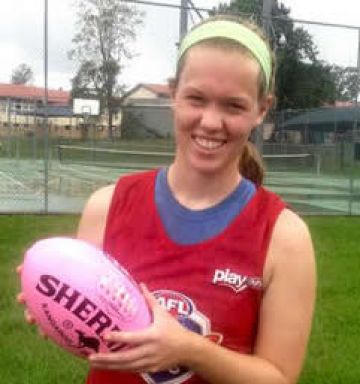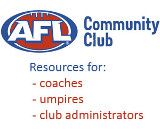Milwaukee's Heather O'Keeffe Gives an Update from Queensland
|
|
They say that those who cannot play coach; that is what I have found myself doing on the Sunshine Coast in Queensland, Australia and not because my skills are inferior.
My dad is a founding member of the USAFL and by default I have grown up around footy. For as long as I can remember I have been watching footy in the park, and I probably learned to handball before I learned to throw a spiral.
It is fair to say that I grew up around footy as much as any American kid possibly could. I have cleaned the house for countless end of season Milwaukee Bombers parties and done chores with more than a couple scholarship players.
At the 2007 Nationals in Louisville I was put to work, selling merchandise and collecting used footy boots for charity. The 2007 national tournament was also the first time I played a game of footy; I was 13. I have played in every national tournament since then, from the ridiculously cold Colorado Spring Nationals to the 2009 tournament where the Milwaukee Lady Bombers took home gold. My involvement has not stopped at just playing; if you have ever been to a national tournament you have probably seen me selling t-shirts, helping in the awards ceremony, and most recently goal umpiring.
Late 2011 I decided to go to Australia for six months, taking a gap semester. I would live and go to school at Nambour State High School on the Sunshine Coast. One of the many things I was keen to do was play footy. However at the time I was not fully aware that I was entering rugby league land.
Mid-February my school had a Girls’ AFL day, without a doubt I was there. The day started out with a briefing of the rules, to my surprise I knew the most. One or two of the girls in attendance had played before, most had only played rugby, and some were just there to get out of school for the day.
Throughout the day I came to the strange realization that I was the best at AFL in the whole school, despite my being American. Girls were confused that there was not a set amount of tackles and that you could move any direction you wanted. They were not accustomed to free flowing AFL. (I say AFL because in Queensland if you say footy, then everyone thinks you are taking about rugby).
The Girls’ AFL Day was organized to attract girls to play in the newly formed U-15 Youth Girls Sunshine Coast League. The organizers quickly showed an interest in the American girl who could play AFL. An article was written and I was asked to coach the local team, they even paid for my coaching accreditation. I declined the responsibility of coaching, I am here for more than AFL, but have been very involved, assisting at trainings and running at the games.
The U-15 Girls competition was the first of its kind of the Sunny Coast and so there was nowhere for me to play competitively. Finding enough interest and commitment for the U-15 competition has difficult enough; it would be very hard to sustain any more female age groups.
As recruitment has showed on the female side in the U.S.A. it is hard to draw females to the traditionally male AFL. Now imagine recruitment for young female teenagers who have played minimal contact sports like netball and volleyball all their life, in an area where AFL is not the dominant sport, rugby is. For mainly these two reasons numbers at training and games has been minimal. Generally we have four girls at training and we combine with the U-14 boys. Training sessions are the only times I get to play (aside from a school carnival), and I have no problem showing the little, smelly boys what’s up. Sometimes the boys are hesitant to go against us girls, but we go hard for the tackle every time, showing no reluctance. It’s girl power at its best, and always so sweet when you beat a cocky boy.
Watching these girls play is very impressive, especially considering the lack of female AFL structure in the area. Many girls had never kicked a footy until the night before or day of the season launch, yet they were playing remarkably given the circumstances. The few girls who had played before on a boys’ team were unreal, showing their presence on the field. You cannot help but wonder what these girls could be capable if they had played in an organized girls competition for several years.
The girls also show no reservations, they are not scared of the ball or of taking a hit. At least once a game I have to run on and remind our youngest player, just 12 and half, to stop slinging girls to the ground.
There is definitely some irony present in the whole situation. I have grown up with grassroots, amateur USAFL and seen the growth of the game in the U.S.A. I have heard many discussions during Nationals about teams lacking numbers and what to do; I myself was recruited to play in 2007 to make up numbers. When I arrived in Australia, I thought I would find an organized league to play in, yet here I am working to recruit and gain interest in AFL.
So at the 2012 Nationals in Mason, Ohio when teams are struggling for number and three cities have combined into one team, I will just chuckle to myself. AFL is a great sport; it’s a hodgepodge of several sports, which makes it so accessible to any athlete. Yet Australia’s only indigenous sport does not even dominate the whole country; for AFL’s greatness it has a lot of sporting culture in Queensland and America to permeate.
|
|
|






